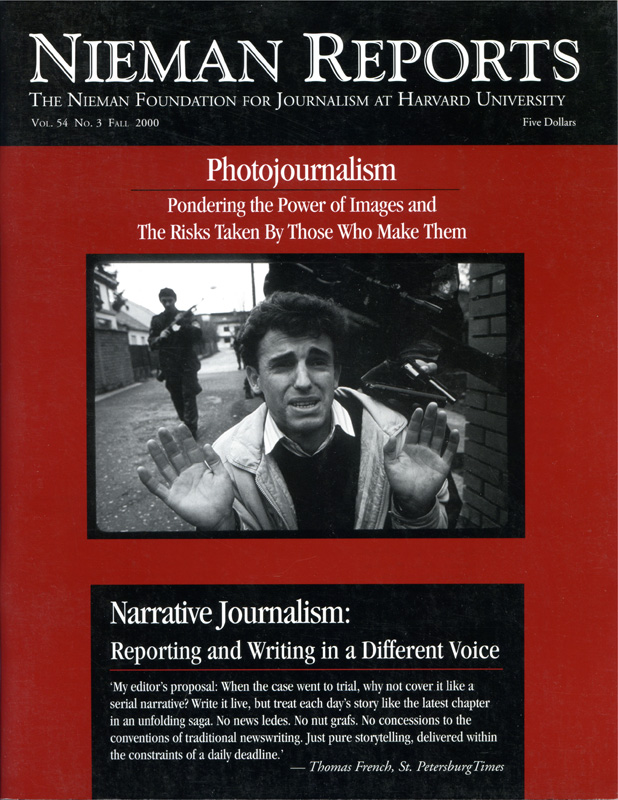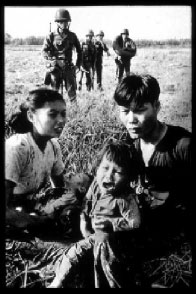Vietnam 1965, photos by Steve Northup.I proudly admit that Jim Nachtwey is a friend and has been for many years. Bias aside, I am very happy we have him on the planet. His work is a true gift to humankind. He holds a caring, relentless mirror on our species, and the images he creates disturb. And they ought to.
I looked through “Inferno” at a local bookstore, then spent the rest of the day in serious depression. It’s not that the photographs are disturbing and occasionally brutal. It’s just that we have been presented so very little real-life context in which to view them. If the only photographs we ever see of Africans are of fly-covered starvation victims, that image soon becomes what we picture as the norm. And, in time, it becomes what we expect to see.
This isn’t Jim’s fault. It’s the fault of editors (and bean counters) who ignore the rest of the world to bring us all-Elian all the time, O.J. without end, and Monica ad nauseam, and think it’s news. Last night, it was green catsup. Get serious. Until we are exposed to realistic coverage of the planet by witnessing people’s daily, productive lives, the tender moments of them loving their children, caring for their neighbors, tending to their crops, smiling, then for God’s sake, we have no idea of their actual existence. One can go for weeks without hearing the word “Africa” on American news broadcasts.
As painful as it is to view, this kind of work is even more difficult to produce. We, the viewer, see only tiny slices of time. The photographer sees it all, hears it all, smells it all, and can’t hide behind the camera. When you are photographing terrible things you have to pay extra attention. You become one with the scene; the camera almost disappears.
Images of death and terror I made in Vietnam 35 years ago still inhabit my dreams and wakefulness. The cries of one small girl, whose baby brother had been killed, whose father was captured and soon to be taken away, whose mother was left with half a family and little hope, will always be with me. Vietnam was the most photographed war in history, and this act of frontline witness will not be repeated. Thanks to the course devised by Ms. Thatcher in the Falklands, our fellows in the Pentagon have made sure that the American public will never again be bothered by scenes of their loved ones killing or being killed. We have sanitized war, or its images, and all but a few of the major players in American journalism were only too happy to oblige. “Please throw us into that pool,” most of them begged.
This is a terrible disservice to all of us, for we are the ones paying for these wars with the blood of our children, the gold of our treasury, the name of our nation.
It was not only the Vietnam photographs shot by the professionals that changed hearts and minds. Almost every GI carried a camera (every PX sold them cheaply) and they carried them everywhere. At almost every small outpost I went to, some GI would come over and want to show me his snapshots. And nine times out of 10, they were truly disturbing. Body parts, mainly. Bits and pieces, not only of the enemy, but of friends and fallen comrades. “That’s Hank,” one GI told me, exhibiting a vivid splash of red against the green jungle floor.
War is about death. These young soldiers in Vietnam captured it in dying color, vividly, graphically and horribly.
Edwin Land once said that we photograph things so as not to be afraid of them. These GI’s proved his point. I think it was these photos sent home if not to Mom, then to younger brothers, uncles, best friends, that brought the real horror of Vietnam into the American home. Our journalistic efforts were self-censored, and we tried to show facets other than death: the soldiers’ courage, the war’s tedium, even the beauty of the country that became our battlefield made it into our coverage. These GI’s used no such filter. In their images, through their eyes, the war was raw and dirty and ugly and personal, and they sent it home in tidy little stacks of four-by-six inch prints.
There was also another dark side to photographing in Vietnam. While we went into combat unarmed, we could also leave any time we had had enough. Well, not just any time, but we could make a dignified retreat on outgoing helicopters. And when you started out on the day’s march, one thing weighed in your mind: If you were going to make any really good images that day, something would have to happen; people would have to be hurt or killed. Otherwise it was just another long hot walk. These are not good thoughts to carry in one’s head, and they have always induced guilt.
I liked the men I went to war with, both Vietnamese and Americans, and didn’t want anything terrible to happen to them. My strongest memory of that place was one of sorrow: I felt sorry for everyone, on all sides, all the time. One other photograph of mine sticks in my mind. It is a sort of a peaceful one: a young Marine private, nestled up against a gravestone in a Vietnamese cemetery in a hard rain. He was cold, wet, scared and 10,000 miles from home and, in his wallet, next to his photos of folks back home, he carried a small card given to him by his government. It told him the 10 reasons he was there. I pray we will never again send our children into a war where such a card is needed.
Lastly, the question arises, did we, as photographers of that war, do any good? I think so. I doubt we moved masses of minds, but our photographs have a lasting effect on individuals. And they help with the healing. A few weeks ago, as part of a week spent as an instructor at the Santa Fe Photographic Workshops, I presented a slide show of my favorite works. I started out with about 40 images from Vietnam. At night’s end, a fellow walked up to me as I was going to my pickup. “I want to thank you,” he told me. “I spent two years in that terrible place and I want to tell you that tonight, you reminded me of what photography is all about. Please keep showing the pictures.”
I will.

Steve Northup covered Vietnam as a staff photographer for United Press International in 1965-1966. He later served as a photographer for The Washington Post and Time magazine. He is a 1974 Nieman Fellow and lives in New Mexico.



